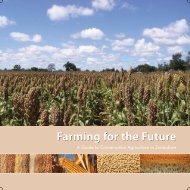Restoring the Soil - Canadian Foodgrains Bank
Restoring the Soil - Canadian Foodgrains Bank
Restoring the Soil - Canadian Foodgrains Bank
Create successful ePaper yourself
Turn your PDF publications into a flip-book with our unique Google optimized e-Paper software.
24Choosing The Right GM/CC Cropping System For A Specific Areaspecies that can be eaten, fed to animals, or provide some o<strong>the</strong>r benefit for which astrong felt need exists among <strong>the</strong> farmers.In general, good gm/cc species should establish <strong>the</strong>mselves easily and grow rapidlyunder local conditions; be able to cover weeds quickly; and be able to fix plenty ofnitrogen. They also should be resistant to insects, diseases, grazing animals, bush fires,droughts, or any o<strong>the</strong>r problem <strong>the</strong>y may have to face within <strong>the</strong> cropping system. Aswell, <strong>the</strong>y should produce enough seed for future plantings. If <strong>the</strong> gm/ccs are to beused for intercropping, <strong>the</strong>y should withstand shade and fit in with <strong>the</strong> growing cycleof <strong>the</strong> main crops.Note that virtually all of <strong>the</strong> gm/cc systems recommended in this book fall within <strong>the</strong>above rules that favour easy adoption by farmers.Gm/ccs have also become very useful for large-scale farmers who cultivate as much as100,000 ha of land in Brazil. However, among smallholder farmers, gm/ccs tend to bemost useful for those who have between 0.25 ha to 10 ha of land. Farmers who havemore than 10 ha can still use fallows to maintain <strong>the</strong> fertility of <strong>the</strong>ir soils. It is fairlydifficult, though definitely possible, for gm/ccs to compete with fallowing, becausegm/ccs require more labor. For farmers who have less than 0.25 ha, <strong>the</strong> use of <strong>the</strong> landis usually so intense that <strong>the</strong>re are virtually no times or places when <strong>the</strong> farmers aren’tusing <strong>the</strong> land. Thus, <strong>the</strong>re is much less opportunity to use gm/ccs. In <strong>the</strong>se cases, it isoften better for farmers to make compost or buy organic or chemical fertilizer.Farmers who dedicate <strong>the</strong>ir land to year-round paddy rice production also may nothave any good way to use gm/ccs.Collecting <strong>the</strong> Necessary InformationThe first step in choosing one or more gm/cc system(s) for a particular area is to getto know <strong>the</strong> area well. Some information is absolutely essential before you can choose<strong>the</strong> best systems for a given area. This includes:1.2.3.4.5.Do <strong>the</strong> farmers have any preferences as to how <strong>the</strong>y want to solve <strong>the</strong> soil fertilityproblem, and if so, what are <strong>the</strong>y? Have <strong>the</strong>y tried some techniques already?What were <strong>the</strong> results? Why?At what elevation above sea level is <strong>the</strong> area? Zero to 800 metres (m) above sealevel, 800 to 1,500 m, 1,500 to 3,000 m or above 3,000 m?What leguminous grains or leaves do people already know and eat?For what leguminous plants is <strong>the</strong>re a good market?When asked what <strong>the</strong>ir major agricultural problems are, do farmers (men andwomen) see soil fertility as one of <strong>the</strong> top two or three? Take care not to bias thisquestion by former comments, by how <strong>the</strong> question is asked, or even by such
















